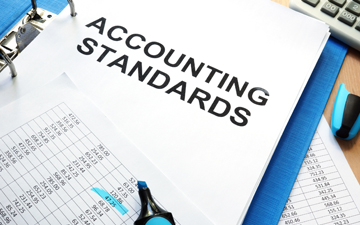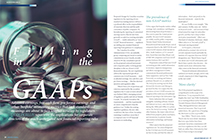CSA proposes revised non-GAAP and other financial measures rule

Following stakeholder consultation, the umbrella group of securities regulators has made substantive changes to the proposed instrument
 |
The Proposed Instrument presents substantive changes to the CSA's Original Materials on non-GAAP measures, writes Matthew Merkley of Blakes. |
TORONTO – The Canadian Securities Administrators (CSA) recently issued a request for comment on revisions to proposed National Instrument 52-112 Non-GAAP and Other Financial Measures Disclosure (Proposed Instrument), which would provide for binding requirements for issuers disclosing non-GAAP (generally accepted accounting principles) and certain other financial measures, and replace current CSA staff guidance.
BACKGROUND
Currently, non-GAAP financial measures included in public disclosure by reporting issuers in Canada are subject to regulatory guidance contained in CSA Staff Notice 52-306 (Revised) Non-GAAP Financial Measures (SN 52-306). For more information, see our February 2016 Blakes Bulletin: CSA re: Non-GAAP, TSX NCIB FAQs and Other Acronyms.
On September 6, 2018, the CSA first published for comment the original version of the Proposed Instrument (Original Materials) meant to replace SN 52-306. For more information, see our September 2018 Blakes Bulletin: CSA Proposes Non-GAAP Financial Measures Rule. The CSA subsequently conducted 38 outreach sessions across seven cities in Canada and reviewed 42 comment letters from issuers, investors, accounting firms, standard setters, industry associations and law firms.
Following stakeholder consultation, the CSA has made substantive changes to the Proposed Instrument, aimed to:
-
Reduce the scope of application to certain issuers
-
Exempt certain disclosure, financial measures and types of documents
-
Narrow and clarify various definitions
-
Simplify the disclosure for non-GAAP financial measures that are forward-looking information and non-GAAP ratios
-
Limit disclosure for capital management measures and total of segment measures
-
Permit cross-referencing (incorporation by reference to management discussion and analysis) in certain circumstances
-
Better align disclosure requirements with those adopted by other securities regulators
-
Enhance readability
-
Reduce uncertainty regarding disclosure obligations by clarifying disclosure requirements and including significant guidance
Scope
The revisions made to the Proposed Instrument reduce the scope of its application significantly as compared to the Original Materials, addressing concerns over, among other things, the potential for regulatory burden. For more information, see our November 2019 Blakes Bulletin: Burden Reduction: OSC Addresses 199 Problems. The Proposed Instrument will only apply to (i) reporting issuers in respect of disclosure in a document that is intended to be, or reasonably likely to be, made available to the public, and (ii) non-reporting issuers in a document that is subject to the prospectus requirements, filed with securities regulatory authorities in connection with a distribution of securities made in reliance on the offering memorandum exemption, or submitted to a recognized stock exchange in connection with a qualifying transaction, reverse take-over, change of business, listing application, significant acquisition or similar transaction.
The Proposed Instrument will not apply to investment funds, "designated foreign issuers" or "SEC foreign issuers" (as defined in National Instrument 71-102 – Continuous Disclosure and Other Exemptions Relating to Foreign Issuers). In addition, subject to certain exceptions, the Proposed Instrument will not apply to disclosure required under National Instrument 43-101 Standards of Disclosure for Mineral Projects and National Instrument 51-101 Standards of Disclosure for Oil and Gas Activities, to financial measures disclosed by an issuer in compliance with a requirement under law or by a self-regulatory organization of which the issuer is a member, to pro forma financial statements required to be filed under securities legislation (but it would apply to those filed voluntarily) and oral statements (or transcripts thereof).
The CSA's discussion of comments received on the Original Materials indicates that the Proposed Instrument would apply to any of the covered financial measures disclosed by an issuer, not just the issuer's own financial measures, as the CSA rejected a comment that the Proposed Instrument be limited to disclosures of the issuer's own financial information.
"Primary Financial Statements" and Notes
The definition of "primary financial statements" in the Proposed Instrument remains unchanged from the definition set out in the Original Materials. The Proposed Instrument continues to define "primary financial statements" to be an issuer's statement of financial position, statement of profit or loss and other comprehensive income, statement of changes in equity and statement of cash flows, but not the notes thereto. The definition of a non-GAAP financial measure—discussed below—in the Proposed Instrument excludes measures that are presented within the financial statements of an entity.
Non-GAAP Financial Measures that are Historical Information
The expanded definition of "non-GAAP financial measure" proposed in the Original Materials has been changed in response to comments received by the CSA. The new definition set out in the Proposed Instrument is more consistent with the definition currently in SN 52-306 and with rules and guidance of other securities regulators, including the U.S. Securities and Exchange Commission.
Pursuant to the Proposed Instrument, a "non-GAAP financial measure" means a financial measure presented by an issuer that (a) depicts the historical or expected future financial performance, financial position or cash flow of an entity; (b) with respect to its composition, excludes an amount that is included in, or includes an amount that is excluded from, the composition of the most comparable financial measure presented in the primary financial statements of the entity; (c) is not presented in the financial statements of the entity; and (d) is not a ratio.
This revised definition reduces the scope of financial measures captured under the Proposed Instrument compared to the Original Materials. In particular, ratios that are not non-GAAP ratios—discussed below—are specifically excluded from the defined term. Accordingly, ratios extracted directly from an issuer's financial statements or calculated using a component of a line item from the financial statements—where the component is calculated in accordance with an issuer's accounting policies used to prepare the line item presented in the financial statements—would not meet the definition of "non-GAAP financial measure," but may meet the definition of a "supplementary financial measure"—discussed below.
Similar to SN 52-306, the Proposed Instrument would require the following for non-GAAP financial measures that are historical information:
-
Non-GAAP financial measures be labelled using a term that, (a) given the measure's composition, describes the measure, and (b) distinguishes the measure from totals, subtotals and line items presented in the entity's primary financial statements.
-
The document containing the non-GAAP financial measure must present the most comparable financial measure that is presented in the entity's primary financial statements to which the non-GAAP financial measure relates.
-
Non-GAAP financial measures be presented with no more prominence in the document than the most comparable financial measure referred to in item 2 above.
-
The document presents the non-GAAP financial measure, determined using the same composition, for a comparative period unless impracticable to do so.
-
In proximity to the first instance of each non-GAAP financial measure in each document, the document must: (a) identify the measure as a non-GAAP financial measure; (b) explain that the non-GAAP financial measure is not a standardized financial measure under the financial reporting framework used to prepare the issuer's financial statements and might not be comparable to similar financial measures presented by other issuers; (c) explain the composition of the non-GAAP financial measure; (d) provide, directly or by incorporating by reference—as permitted by the Proposed Instrument in certain cases—an explanation of how the non-GAAP financial measure provides useful information to an investor and explains the additional purposes, if any, for which management uses the non-GAAP financial measure; and (e) provide, directly or by incorporating by reference—as permitted by the Proposed Instrument in certain cases—a quantitative reconciliation, to the most comparable financial measure referred to in item 2 above.
-
Provide, directly or by incorporating by reference—as permitted by the Proposed Instrument in certain cases—an explanation of the reason for a change from the comparative period, if any, in the label or composition of a non-GAAP financial measure.
Of note, the most comparable measure must be presented in the entity's primary financial statements, and not the notes thereto. The CSA considered and rejected a comment on the Original Materials suggesting that the comparable measure could be found anywhere in the financial statements.
The Proposed Companion Policy clarifies that it would be impracticable for an issuer to provide comparative disclosure when the period in which such non-GAAP financial measure appears is the first period of operation and no comparative period exists. The Proposed Companion Policy specifically notes that the CSA does not consider cost or the time involved in preparing comparative information to be sufficient rationale for an issuer to assert that it is impracticable to present such information. Similarly, the Proposed Companion Policy provides that the CSA will not consider adoption of a new accounting standard, which would include adoption of amendments to current accounting standards, or a change in accounting policy, a reasonable basis for not presenting comparative period disclosure.
Non-GAAP Financial Measures that are Forward-Looking Information
The Proposed Instrument provides that an issuer must not disclose a non-GAAP financial measure that is forward-looking information (as defined in National Instrument 51-102 Continuous Disclosure Obligations) in a document unless an issuer complies with all of the following requirements:
-
The non-GAAP financial measure that is forward-looking information is labelled using the same label used for the historical non-GAAP financial measure
-
The document presents the historical non-GAAP financial measure
-
The non-GAAP financial measure that is forward-looking information is presented with no more prominence in the document than that of the historical non-GAAP financial measure (which, itself, is to be presented with no more prominence than the most comparable GAAP measure as is noted in the Proposed Companion Policy)
-
In proximity to the first instance of the non-GAAP financial measure that is forward-looking information in the document, the document provides, directly or by incorporating by reference—as permitted by the Proposed Instrument in certain cases—a description of any significant difference between the non-GAAP financial measure that is forward-looking information and the historical non-GAAP financial measure
The disclosure requirements for non-GAAP financial measures that are forward-looking information have been substantially revised from what was proposed in the Original Materials to reduce disclosure requirements. Specifically, the quantitative reconciliation proposed in the Original Materials has been removed and replaced with a requirement to describe any significant differences between the non-GAAP financial measure that is forward-looking information and the historical non-GAAP financial measure which the CSA refers to as "a requirement to describe each reconciling item between the non-GAAP financial measure that is forward-looking information and the historical non-GAAP financial measure."
In response to comments, the Proposed Instrument provides that the above requirements will not apply if the disclosure is made by an SEC issuer—as defined in National Instrument 52-107 Acceptable Accounting Principles and Auditing Standards—and is made in compliance with Regulation G under the U.S. Securities Exchange Act of 1934.
Non-GAAP Ratios
The Proposed Instrument defines a "non-GAAP ratio" as a financial measure presented by an issuer in the form of a ratio, fraction, percentage or similar representation and that has a non-GAAP financial measure as one of its components. Ratios that are calculated using exclusively financial measures that are presented in the primary financial statements or operating measures or other measures that are not non-GAAP financial measures would not meet the definition of a non-GAAP ratio. For example, working-capital ratio would not meet the definition if the ratio is calculated as total current assets divided by total current liabilities, as both total current assets and total current liabilities are presented in the primary financial statements. Similarly, a percentage increase or decrease year over year with respect to a line item presented in the primary financial statements—or a component of such line item—for the purpose of variance analysis would not meet the definition of a non-GAAP ratio. Further, similar to guidance currently provided in SN 52-306 and contrary to the Original Materials, "sales per square foot" would not be considered a "non-GAAP ratio," provided "sales" does not exclude an amount that is included in, or include an amount that is excluded from, "sales," as presented in the primary financial statements of the entity.
The disclosure requirements for non-GAAP ratios have been reduced in the Proposed Instrument relative to the Original Materials such that the Proposed Materials would require that:
-
The non-GAAP ratio be labelled using a term that, given the non-GAAP ratio composition, describes the non-GAAP ratio
-
The non-GAAP ratio be presented with no more prominence in the document than that of similar financial measures presented in the primary financial statements of the issuer
-
In proximity to the first instance of each non-GAAP ratio in each document, the document: (a) explains the composition of the non-GAAP ratio and identifies each non-GAAP financial measure that is used as a component of the non-GAAP ratio; (b) explains that the non-GAAP ratio is not a standardized financial measure under the financial reporting framework used to prepare the financial statements of the entity and might not be comparable to similar financial measures presented by other issuers; (c) provides, directly or by incorporating by reference—as permitted by the Proposed Instrument in certain cases—an explanation of how the non-GAAP ratio provides useful information to an investor and explains the additional purposes, if any, for which management uses the non-GAAP ratio; and (d) provides, directly or by incorporating by reference—as permitted by the Proposed Instrument in certain cases—an explanation of the reason for a change from the comparative period, if any, in the label or the composition of the non-GAAP ratio.
In addition to the foregoing, the Proposed Instrument would further require issuers to present the non-GAAP ratio for a comparative period, using the same means of calculation unless the non-GAAP ratio is forward-looking information, or it is impracticable—as described in the Proposed Companion Policy—to present the measure for the comparative period.
Total of Segments Measure
For purposes of the Proposed Instrument, "total of segments measures" are financial measures presented by an issuer that are (a) a subtotal or total of financial measures of two or more reportable segments of an entity, and (b) presented in the notes to the financial statements of the entity but is not presented in the primary financial statements of the entity.
The defined term "segment measure" in the Original Materials was revised so as to refer to a subtotal of a reportable segment, or a total of two or more reportable segments, and not measures of "segment profit or loss, revenue, expenses, assets or liabilities" disclosed in financial statement notes.
The Proposed Instrument provides that an issuer must not disclose a total of segments measure in a document, other than financial statements of the entity to which the measure relates, unless:
-
The document presents the most comparable financial measure presented in the primary financial statements of the entity
-
The total of segments measure is presented with no more prominence in the document than that of the most comparable financial measure referred to referred to in item 1 above
-
In proximity to the first instance of the total of segments measure in the document, the document provides, directly or by incorporating it by reference—as permitted by the Proposed Instrument in certain cases—a quantitative reconciliation of the total of segments measure to the most comparable financial measure referred to in item 1 above
-
The document presents the total of segments measure, determined using the same composition, for a comparative period, if the total of segments measure for the comparative period has been previously disclosed
To the extent a total of segments measure is presented or disclosed in an issuer's primary financial statements or notes thereto, it will not be a "non-GAAP financial measure" under the Proposed Instrument. However, the Proposed Companion Policy notes that a financial measure of a reportable segment may be "non-GAAP financial measures" under the Proposed Instrument if it is (a) disclosed outside the issuer's financial statements—for example, in MD&A or an annual information form—and (b) not presented in the financial statements to which the financial measure relates.
Capital Management Measures
For purposes of the Proposed Instrument, "capital management measures" are financial measures presented by an issuer that are (a) intended to enable a person to evaluate an entity's objectives, policies and processes for managing its capital, and (b) presented in the notes to the financial statements of the entity but not presented in the primary financial statements of the entity.
The Proposed Instrument outlines a regime governing capital management measures disclosed in a document other than the financial statements, that is similar to the proposed regime for non-GAAP financial measures, including requirements with respect to the prominence of such disclosures, an explanation of their composition, an explanation of how it provides useful information to investors and is used by management, a quantitative reconciliation (other than ratios), and presentation of the measure for a comparative period if there has been prior disclosure of the measure.
The Original Materials were revised such that the Proposed Instrument allows issuers to make certain disclosure relating to capital management measures, including explanations of their composition and usefulness and quantitative reconciliations, within the entity's financial statements instead of directly within other documents in which such measures are disclosed.
The Proposed Companion Policy states that if a capital management measure was calculated using one or more non-GAAP financial measures, the issuer must comply with the non-GAAP financial measures provisions in respect of each non-GAAP financial measure used.
Supplementary Financial Measures
For purposes of the Proposed Instrument, "supplementary financial measures" are financial measures that (a) are, or are intended to be, disclosed on a periodic basis to depict the historical or expected future financial performance, financial position or cash flow of an entity; (b) are not presented in the financial statements of the entity; (c) are not non-GAAP financial measures; and (d) are not non-GAAP ratios.
As an example, the Proposed Companion Policy provides that an entity that operates in the retail industry may consider same-store sales as a supplementary financial measure. Such an entity may disclose same-store sales—where same-store sales, a component of overall sales, is calculated in accordance with the accounting policies used to prepare the sales line item presented in the primary financial statements—to report sales performance from period to period.
The Proposed Instrument provides that an issuer must not disclose a supplementary financial measure in a document unless:
-
The supplementary financial measure is labelled using a term that, (a) given the measure's composition, describes the measure, and (b) distinguishes the measure from totals, subtotals and line items presented in the primary financial statements of the issuer
-
In proximity to the first instance of the supplementary financial measure in the document, the document provides an explanation of the composition of the supplementary financial measure
For clarity, the Proposed Companion Policy provides that if an issuer discloses a financial measure that is a component of a financial statement line item to explain how the financial statement line item changed from period to period, such a measure would not meet the definition of a supplementary financial measure, so long as the measure is not intended to be disclosed on a periodic basis.
Unlike the Original Materials, the Proposed Instrument does not require an issuer to disclose the same supplementary financial measure for the comparative period and explain the reason for changes, if any, from the comparative period.
Other
Incorporation by Reference
The Proposed Instrument allows issuers to cross-reference certain discrete disclosure, including quantitative reconciliations, by incorporating by reference from the issuer's MD&A only. In order to incorporate such disclosure by reference, the MD&A must be filed on the System for Electronic Document Analysis and Retrieval (SEDAR) and the specific location within the issuer's MD&A of the disclosure required by the Proposed Instrument must be identified. Of note, the Proposed Instrument would not permit such incorporation by reference in a news release issued or filed by an issuer. We believe this would be a significant change for many issuers, in particular with respect to earnings releases.
Prominence
Determining the relative prominence of a non-GAAP financial measure or other measure is a matter of judgment, considering the overall disclosure and the facts and circumstances in which the disclosure is made. In the Proposed Companion Policy, the CSA has provided a non-exhaustive list of examples that it considers would cause a measure to be more prominent than the most comparable measure presented in the primary financial statements. The list includes, but is not limited to, omitting the most comparable GAAP measure from a news release headline or caption that includes a non-GAAP financial measure, or presenting a non-GAAP financial measure using a style of presentation that emphasizes the non-GAAP financial measure over the most comparable measure. Additionally, the Proposed Companion Policy continues to provide for the safe harbour contemplated in the Original Materials by noting "a location is not more prominent if it allows an investor who reads the document, or other material containing the non-GAAP financial measure, to be able to view the discussion and analysis of both the non-GAAP financial measure and the most comparable measure contemporaneously. For example, within the previous, same or next page of the document."
Reconciliation
The Proposed Instrument requires that issuers provide a quantitative reconciliation between a non-GAAP financial measures and the most comparable financial measure presented in the primary financial statements. For purposes of presenting the reconciliation, the Proposed Companion Policy suggests that issuers begin with the non-GAAP financial measure or the most comparable financial measure presented in the primary financial statements, and separately itemize and explain each significant reconciling item in a comprehensible and consistent manner. While the Proposed Instrument does not define the "most comparable financial measure," requiring that issuers apply judgment, the Proposed Companion Policy notes that, in applying such judgment, it is important for an issuer to consider the context of how the non-GAAP financial measure is used. For example, the Proposed Companion Policy states that where the non-GAAP financial measure is discussed primarily as a performance measure used in determining cash generated by the issuer or its distribution-paying capacity, its most directly comparable GAAP measure will be from the statement of cash flows.
Websites and Social Media
The Proposed Companion Policy notes that an issuer should not disclose a non-GAAP financial measure, a non-GAAP ratio, a total of segments measure, a capital management measure or a supplementary financial measure using social media, if it is unable to include all relevant disclosure through the applicable platform. Further, the Proposed Companion Policy states that if an issuer uses social media to provide links to a publication—such as analyst reports—such publication would be within the scope of the Proposed Instrument, which is a somewhat remarkable proposition for publications not prepared by the issuer.
Executive Compensation Disclosure
The CSA rejected comments on the Original Materials that the Proposed Instrument should not apply to executive compensation disclosure, stating that they "did not see the policy rationale specific to executive compensation that should be different than other uses of non-GAAP financial measures." Accordingly, the Proposed Instrument would apply to Form 51-102F6 Statement of Executive Compensation disclosures, which currently requires issuers to disclose performance goals or similar conditions that are non-GAAP financial measures to explain how the issuer calculates these performance goals or similar conditions. Non-GAAP financial measures would not be exempted from additional compliance with the Proposed Instrument unless a non-GAAP financial measure is identified and the calculation is described, in narrative, but no financial amount is presented.
CONCLUSION
The Proposed Instrument presents substantive changes to the Original Materials. Although the Proposed Instrument presents a more streamlined approach to the disclosure requirements for non-GAAP financial measures and other covered measures compared to the Original Materials, it is still a complex and detailed regime and will represent a departure from current practice for many issuers. The CSA has requested that comments on the Proposed Instrument and Proposed Companion Policy be provided in writing on or before May 13, 2020. The CSA's discussion of comments received on the Original Materials indicates that it is in agreement with and will consider, if adopting the Proposed Instrument, an effective date that follows a long transition period, and coincides with the beginning of an annual financial reporting period to facilitate consistent and comparable reporting over periods.
By Matthew Merkley, Brendan Reay and Raees Nakhuda of Blake, Cassels & Graydon LLP. Matthew Merkley is a partner at Blake, Cassels & Graydon LLP in Toronto and Co-Head of Blakes Toronto's Corporate Governance Practice. Brendan D. Reay is a partner at Blakes. Raees Nakhuda is an associate at Blakes.









(0) Comments